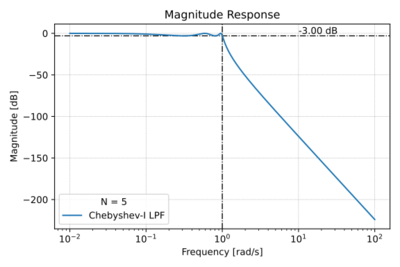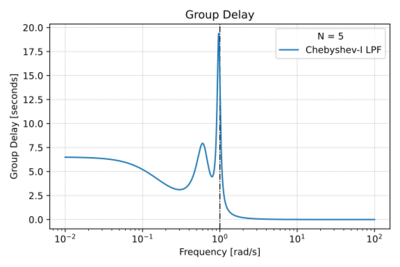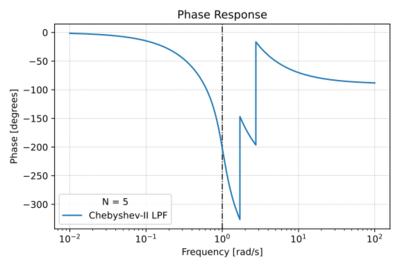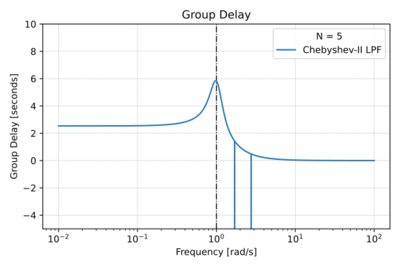Chebyshev filters come in two flavors: the more popular Type-I and the Type-II Chebyshev filter.
The Chebyshev Type-I Low-Pass Filter
Chebyshev Type-I filters are also all-pole filters, with poles of the normalized ( ) filter located on an ellipse inside the unit circle, as shown in Fig. 1. This arrangement of poles results in (1) a shorter transition band, and therefore a steeper roll-off compared to the Butterworth low-pass filter of the same order, shown in Fig. 2, (2) poorer group delay characteristics as depicted in Figs. 3 and 4, and (3) ripples in the pass-band also seen in Fig. 2. By allowing larger ripples in the pass-band, we get: (1) a narrower transition band, and hence sharper cut-off, (2) higher Q poles, and (3) more degradation in the phase response.
) filter located on an ellipse inside the unit circle, as shown in Fig. 1. This arrangement of poles results in (1) a shorter transition band, and therefore a steeper roll-off compared to the Butterworth low-pass filter of the same order, shown in Fig. 2, (2) poorer group delay characteristics as depicted in Figs. 3 and 4, and (3) ripples in the pass-band also seen in Fig. 2. By allowing larger ripples in the pass-band, we get: (1) a narrower transition band, and hence sharper cut-off, (2) higher Q poles, and (3) more degradation in the phase response.
 Figure 1: The low-pass Chebyshev Type-I pole-zero with  and a  ripple. |
 Figure 2: The low-pass Chebyshev Type-I low-pass filter magnitude response with  and a  ripple. |
 Figure 3: The low-pass Chebyshev Type-I low-pass filter phase response with  and a  ripple. |
 Figure 4: The low-pass Chebyshev Type-I low-pass filter group delay with  and a  ripple. |
The Chebyshev Type-I magnitude response is given by:
-
 |
|
(1)
|
Where  is the filter order,
is the filter order,  is the cut-off frequency,
is the cut-off frequency,  is the ripple factor with ripple
is the ripple factor with ripple  in dB, and
in dB, and  are solutions to the Chebyshev differential equation:
are solutions to the Chebyshev differential equation:
-
 |
|
(2)
|
For a normalized filter, or  , the poles of the Chebyshev Type-I low-pass filter are the roots of
, the poles of the Chebyshev Type-I low-pass filter are the roots of  . In practice, instead of solving this equation directly, we can easily get the roots (and hence the poles) of the filter transfer function using tools such as Python or Matlab.
. In practice, instead of solving this equation directly, we can easily get the roots (and hence the poles) of the filter transfer function using tools such as Python or Matlab.
The Chebyshev Type-II Low-Pass Filter
The Chebyshev Type-II filter of order  has
has  poles and
poles and  zeros for even
zeros for even  , and
, and  zeros for odd
zeros for odd  . It has poles inside and outside the unit circuit, and complex conjugate zeros on the
. It has poles inside and outside the unit circuit, and complex conjugate zeros on the  -axis, creating nulls in the stop-band. It is also less common than the Type-I filter since the roll-off is less steep, and due to its zeros, it requires more components.
-axis, creating nulls in the stop-band. It is also less common than the Type-I filter since the roll-off is less steep, and due to its zeros, it requires more components.
The Chebyshev Type-II magnitude response is given by:
-
 |
|
(3)
|
Where  is the filter order,
is the filter order,  is the cut-off frequency, and
is the cut-off frequency, and  is the attenuation factor with stop-band attenuation
is the attenuation factor with stop-band attenuation  in dB. The poles are the roots of:
in dB. The poles are the roots of:
-
 |
|
(4)
|
And the zeros are given by:
-
 |
|
(5)
|
For  . The characteristics of the Chebyshev Type-II filter are shown in Figs. 1-4.
. The characteristics of the Chebyshev Type-II filter are shown in Figs. 1-4.
 Figure 1: The low-pass Chebyshev Type-II pole-zero with  and a  stop-band attenuation. |
 Figure 2: The low-pass Chebyshev Type-II magnitude response with  and a  stop-band attenuation. |
 Figure 3: The low-pass Chebyshev Type-II phase response with  and a  stop-band attenuation. |
 Figure 4: The low-pass Chebyshev Type-II group delay with  and a  stop-band attenuation. |



























